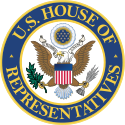United States House Committee on Rules
| Committee on Rules | |
|---|---|
| 114th United States Congress | |
 |
|

Committee Logo
|
|
| History | |
| Founded | April 2, 1789 |
|
New session started
|
January 3, 2015 |
| Leadership | |
|
Chairman
|
|
|
Ranking Member
|
|
| Structure | |
| Seats | 15 members |
|
Political groups
|
Majority (11)
|
| Website | |
| rules |
|
The Committee on Rules, or (more commonly) Rules Committee, is a committee of the United States House of Representatives. Rather than being responsible for a specific area of policy, as most other committees are, it is in charge of determining under what rule other bills will come to the floor. As such, it is one of the most powerful committees and is often described as "an arm of the leadership" and as the "traffic cop of Congress." A rule is a simple resolution of the House of Representatives, usually reported by the Committee on Rules, to permit the immediate consideration of a legislative measure, notwithstanding the usual order of business, and to prescribe conditions for its debate and amendment.
When a bill is reported out of one of the other committees, it does not go straight to the House floor, because the House, unlike the United States Senate, does not have unlimited debate and discussion on a bill. Instead, what may be said and done to a bill is strictly limited. This limitation is performed by the Rules Committee.
When a bill is reported out of another committee with legislative jurisdiction, it is placed on the appropriate House Calendar for debate. Common practice, though, is for bills reported from committees to be considered in the Rules Committee, which will decide for how long and under what rules the full body will debate the proposition.
Consideration by the full body can be in one of two forums: the Committee of the Whole, or on the floor of the full House of Representatives itself. Different traditions govern whether the Committee of the Whole or the House itself will debate a given resolution, and the Rules Committee generally sets the forum under which a proposition will be debated and the amendment/time limitations for every measure, too. For instance, there might be a limit on the number or types of amendments (proposed changes to the bill). Amendments might only be allowed to specific sections of the bill, or no amendments might be allowed at all. Besides control over amendments, the rule issued by the Rules Committee also determines the amount of speaking time assigned on each bill or resolution. If the leadership wants a bill pushed forward quietly, for instance, there might be no debate time scheduled; if they want attention, they might allow time for lengthy speeches in support of the bill.
...
Wikipedia
